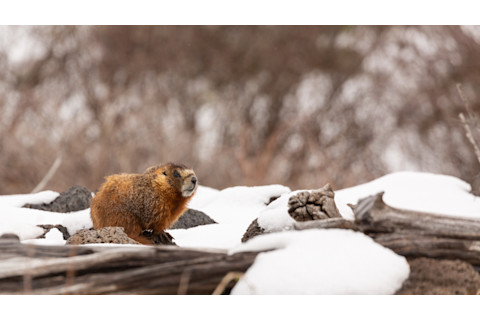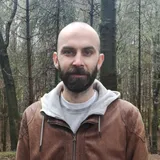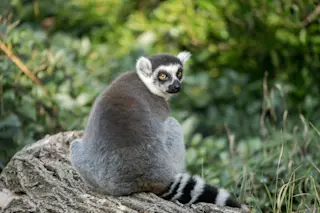When winter arrives, daylight and food is scarce. Hunkering down to avoid the cold probably seems quite appealing. In the animal kingdom, many species have adapted to do just that by hibernating.
You may think of bears when you think of hibernation. But, bears don’t count as true hibernators. Rather they enter a state called “torpor,” a hibernation-like state that’s more akin to a deep sleep. While in this state, a bear’s temperature doesn’t drop drastically, and they can walk somewhat easily. True hibernation consists of a slower heart rate, reduced metabolism, and lowered temperature. So if bears don’t hibernate, what species do?
What Is Hibernation?
Hibernation is not just a mere retreat from the cold; it's an ingenious adaptation that several animal species have developed to conserve energy and survive periods when food is hard to come by.
As winter grips their habitats, some animals enter a state of deep dormancy, slowing down their bodily functions to a bare minimum. This extraordinary process allows them to make it through the winter on stored energy reserves, emerging in spring ready to resume their active lives.
1. Do Woodchucks Hibernate?

(Credit: MelaniWright/Shutterstock)
MelaniWright/Shutterstock
Small rodents like woodchucks, which lie dormant from around October to March, do hibernate and drastically reduce their body temperature and slow their heart from around 100 beats per minute to a mere 4 beats per minute.
Similarly, the Arctic ground squirrel hibernates in deep burrows for around eight months of the year. It’s body temperature drops below freezing, from around 37 degrees Celsius to as low as negative 3 degrees Celsius. When spring comes around, they begin to emerge.
2. Can Birds Hibernate?

(Credit: vagabond54/Shutterstock)
vagabond54/Shutterstock
Just one bird is known to practice hibernation; North America’s common poorwill. This owl-like bird enters a state of torpor during the winter months when the mercury drops and its favored prey – in this case insects – disappear.
During this period the bird’s body temperature, heartbeat, and breathing rate all fall, allowing it to conserve precious energy. Common poorwills may enter this state for a few hours, days or even weeks – the longest stretch recorded is 85 days – and reawaken when temperatures rise again in spring.
Read More: How Does Wildlife Survive Winter's Freezing Temperatures?
3. Do Frogs Hibernate?

(Credit: Jess Lang/Shutterstock)
Jess Lang/Shutterstock
In the forests of Alaska and Canada, wood frogs have developed a bold strategy to survive the winter; they freeze solid. The species has a special adaptation that prohibits ice freezing within their cells, termed a “biological miracle.”
As winter sets in, a kind of antifreeze substance – consisting of glucose and glycogen – forms in their blood and protects its organs as it freezes. When spring comes around, the frog miraculously thaws and goes about its business.
4. Do Reptiles and Fish Hibernate?

(Credit: SLSK Photography/Shutterstock)
SLSK Photography/Shutterstock
Not all species hibernate due to the cold. Animals, such as desert tortoises, rather go into a period of dormancy known as estivation to get through hot, dry months, conserving energy and precious water.
Other animals – including reptiles, fish, and mollusks – replicate this tactic. Crocodiles, for example, may lay in a dormant state buried in a muddy burrow for up to three or four months in a year.
Read More: 6 Different Tactics That Animals Use to Prepare for Winter
5. How Do Lemurs Hibernate?

(Credit: Nattawit Khomsanit/Shutterstock)
Nattawit Khomsanit/Shutterstock
Madagascar’s fat-tailed dwarf lemur enters a hibernation-like state for as much as seven months each year, even when temperatures are as high as 30 degrees Celsius. This peculiar species is the only primate and tropical mammal known to enter a prolonged state of torpor, hiding out in holes in trees during the dry season when its favored food and water is scarce.
Prior to entering this state, the lemur stores fat in its tail, with the enlarged appendage accounting for as much as 40 percent of the critters’ body weight. Throughout the dry season, the lemur curls up and draws energy from its engorged tail, slows down its heart to 4 beats per minute, and breathes every 10 minutes or so.
Other Animals That Hibernate
Other true hibernators include animals such as bats and hedgehogs, while some amphibians and even insects rely on strategies to navigate the cold.
Read More: 5 of the Fiercest Animals in the Tundra
As the earth’s climate changes, some species hibernation patterns are changing in response. Researchers have found that as the freeze and thaw of the Arctic landscape has changed over the past 25 years, the hardy Arctic ground squirrel’s hibernation patterns are adapting. Females are arising from their burrows around 10 days earlier, but males haven’t changed in step. What this means for the squirrel population remains unclear, but it could eventually pose problems for their reproduction.
Frequently Asked Questions About Animal Hibernation
Do Polar Bears Hibernate?
Polar bears do not hibernate in the traditional sense. Pregnant females enter a den for a few months to give birth and care for their young but remain somewhat active.
Do Hamsters Hibernate?
Some species of hamsters can enter a hibernation-like state in extremely cold conditions, but it is not true hibernation.
Do Skunks Hibernate?
Skunks do not hibernate but go into a state of torpor where they remain inactive for longer periods during winter.
Do Raccoons Hibernate?
Raccoons do not hibernate but may sleep for extended periods during extreme cold, reducing their activity significantly.
Do Turtles Hibernate?
Many turtle species go into a state of brumation (a form of hibernation for cold-blooded animals) during cold months, especially aquatic turtles.
Do Rabbits Hibernate?
Rabbits do not hibernate. They remain active throughout the winter and adapt by growing thicker fur and consuming stored food.
Do Snakes Hibernate?
Snakes enter a state of brumation in cold weather, significantly reducing their metabolic rate but not entering true hibernation.
Do Chipmunks Hibernate?
Chipmunks enter a form of hibernation. They sleep for extended periods but wake up periodically to eat stored food.
Do Bees Hibernate?
Bees do not hibernate. In winter, they stay in their hives and survive on stored food, maintaining activity by vibrating their wings to generate heat.
Read More: Top 10 Snow Animals and How They Survive the Cold















